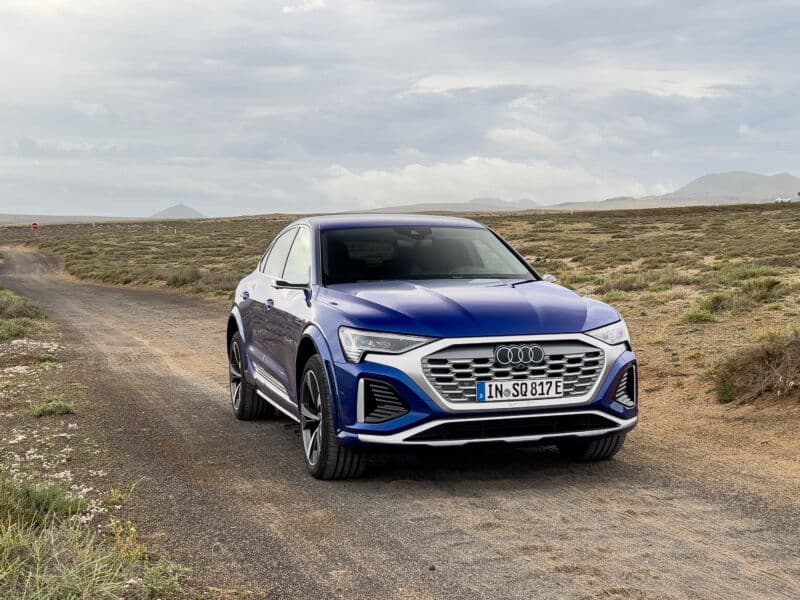
LANZAROTE, SPAIN—The electric vehicle market is still nascent enough that most models are in their first flush of youth. But prevailing wisdom in the industry is that a model should live for about eight years, with a midlife spruce-up or refresh scheduled around year four. Not coincidentally, it’s been about four years since Audi started the production of its first electric SUV, the e-tron, and since then, it has gone on to sell more than 160,000. Now the German automaker has a growing range of EVs, and “e-tron” has been converted from a proper noun to an adjective in its corporate lexicon in the same way “quattro” did several decades before. So this midlife refresh includes a name change—e-tron becomes Q8 e-tron, making plain the rather obvious similarities between this EV SUV and the gas-burning Q8.
When I drove the original e-tron in 2018, I found it solid, if a bit unspectacular. It hit most of the right notes in terms of appearance—Audi knows how to design a handsome shape, and its interiors are at the head of the class, if sometimes a little somber. Developed in rather a short amount of time, the e-tron could only manage a relatively mediocre 2.2 miles/kWh (28.2 kWh/100 km) at launch. That was sufficient for a range of more than 200 miles (321 km), but not much more, although a software update in 2021 increased the useable capacity of the 95 kWh battery pack from 83 kWh to 86 kWh.
Although Audi is still waiting to finalize its EPA numbers ahead of the Q8 e-tron arriving in the US next year, it says it expects the longest-legged version to come in with a range of at least 300 miles (483 km). This will presumably be the lower-drag Sportback, which returns as a body variant.
It required quite a few changes to get there. For starters, there’s a new battery pack between the axles. It has the same dimensions as the old battery, but Audi has changed both the type of cell—now prismatic instead of pouch—and the chemistry, which was nickel-manganese-cobalt but is now nickel-cobalt-aluminum.
The percentage of cobalt is significantly reduced, and Audi says that combined with new battery management software, the changes mean a 20 percent increase in energy density. As a result, US-market Q8 e-trons now pack a total of 114 kWh, of which 106 kWh is useable.
The new pack also fast-charges more quickly than before. It can accept a peak charge of 170 kW, up from 150 kW in the old model, and the charging curve has been optimized to maintain high power rates for as long as possible. Audi told us that fast-charging from 10 to 80 percent should take 31 minutes, and the Q8 e-tron now features ISO 11518 or plug-and-charge capabilities.
There’s a new rear electric motor for the twin-motor, all-wheel drive powertrain, too. Audi continues to use asynchronous electric motors here rather than permanent magnet motors, due to the former’s advantage in terms of drag when not being energized. The Q8 e-tron has moved from 12 to 14 windings around the stator, which generates a stronger magnetic field for the same input of current.
Peak power is 402 hp (300 kW) and 490 lb-ft (664 Nm), although that’s only accessible in bursts while in Dynamic mode. Top speed is a relatively academic (outside of Germany) 125 mph (200 km/h), but the EV’s 0-62 mph (0–100 km/h) time has decreased by a few tenths to 5.6 seconds.
The changes didn’t stop with the powertrain, however. Aerodynamic efficiency has increased through drag reduction; the SUV’s drag coefficient decreased by 0.1 to 0.27, and the Sportback dropped by 0.2 to 0.24. That improvement was due to many small tweaks, like larger wheel spoilers under the car and self-sealing seams near the radiator grille, plus a new fiberglass battery pack cover, dimpled like a golf ball, that saves 15 lbs (7 kg).
There’s also a new front grille that maintains Audi’s hexagonal corporate visage but with less drag. There’s even a new four-ring badge, which now conceals some of the sensors for the SUV’s advanced driver assistance systems like adaptive cruise control and automated emergency braking.
Together, all of these improvements resulted in a 30 percent increase in the Q8 e-tron’s WLTP range, although that European test regime bears little resemblance to real-world driving on US roads. Spec a Q8 with larger wheels and the improvement is unlikely to be as impressive. But riding on 21-inch wheels—which now have self-centering Audi badges—I averaged 2.4 miles/kWh (25.9 kWh/100 km) compared to 2.1 miles/kWh (29.6 kWh/100 km) the last time I drove an e-tron.
Audi has also made the Q8 e-tron a bit more engaging to drive. There’s a new steering rack that’s 10 percent faster. New front axle bushings are stiffer, and there have been software changes to retune how air suspension controls itself over bumps. And the ESC has been reworked to intervene less often, increasing traction in corners.
The revised car feels more engaging to drive—something the previous e-tron never managed to do well. There’s a little more feedback from the steering wheel, and it’s more eager to turn in, without much body roll. I was also impressed with the level of sound isolation—it’s a very quiet cabin to be in, with good blocking of tire, wind, and other exterior noise.
Pricing will be announced closer to the Q8 e-tron’s arrival, but we expect it to increase about 5 percent on the 2022 model. Although the loss of the IRS tax credit makes the electric Q8 a bit less competitively priced than it used to be compared to the gasoline version, the larger battery and improved efficiency solve the biggest problem with the original e-tron.
SQ8 e-tron
While in Lanzarote, we were also able to try out the range-topping SQ8 e-tron, previously imported into the US in such small numbers that all the cars went to customers and none joined the press fleet.
Like the Q8 e-tron we’re getting in North America, the SQ8 e-tron also benefits from the new 106 kWh (useable) battery. Unlike the lesser model, it uses a three-motor arrangement, with a 166-hp (124 kW) motor driving the front wheels and a pair of 131-hp (98-kW) motors for the rear axle, one for each rear wheel.
All three motors can be boosted, however, but peak power for the SQ8 in dynamic mode is limited by the battery’s ability to output a maximum of 496 hp (370 kW). More significant in terms of the driving experience is the 718 lb-ft (973 Nm) of torque.
This is more than enough to get the heavy EV up and moving—an SQ8 e-tron without the driver still checks in at 5,842 lbs (2,650 kg), even more than the 5,534-lb (2,510-kg) Q8 e-tron. The dash to 62 mph (100 km/h) drops by more than a second to 4.5 seconds, and you can eke out an extra 5 mph (10 km/h) in top speed.
Software controls how much torque gets sent to either rear wheel, although each can only receive the output of the motor that drives it, unlike a mechanical torque vectoring axle that distributes torque from an engine. You’re mostly unaware of what the powertrain’s brain is doing, but you do notice the EV’s willingness to corner as the outside wheel gets an additional 162 lb-ft (220 Nm) of torque. The suspension bushings are even stiffer than the new ones on the regular Q8 e-tron, and there’s SQ8-specific tuning for the air suspension and traction and stability control systems.
On the road, the SQ8 e-tron delivers a different experience than the more pedestrian Q8 e-tron. As you set off, you notice a more purposeful low-speed EV sound, a rather growly take on a noise that was memorably described by the Smith and Sniff podcast as a chorus of sad angels.
The steering provided adequate feedback about what the front tires were up to, and the paddles on the steering wheel remain the best way to vary levels of regenerative braking so you can coast when it’s more efficient to do so. A quick note on that—although both the Q8 e-tron and SQ8 e-tron will regeneratively brake at up to 0.3 G, Audi doesn’t offer a true one-pedal driving experience as some other EVs do.
Acceleration in the SQ8 e-tron was also noticeably better—in my notes, I recorded it as being “very punchy but not stupid-fast from a standstill.” With more power and more drag-generating wheels, the efficiency wasn’t quite as good as the regular Q8 e-tron’s, but I still managed 2.3 miles/kWh (27 kWh/100 km).
In terms of expensive electric SUVs, the SQ8 e-tron is not quite as sporty as a BMW iX but more so than a Mercedes-Benz EQS SUV, with perhaps more conventional manners than either. And in Sportback form, it’s probably the prettiest.























